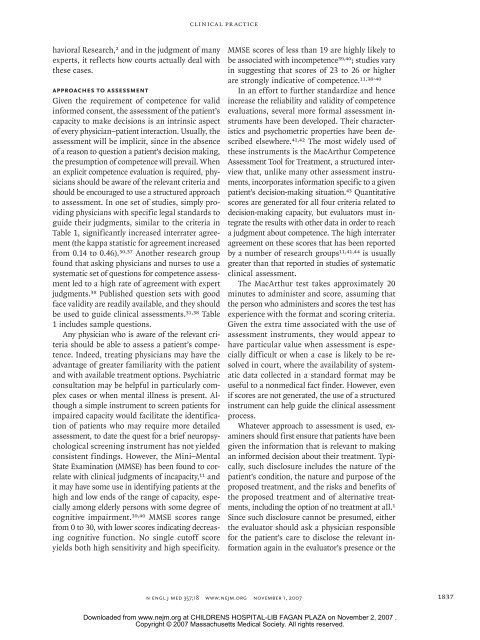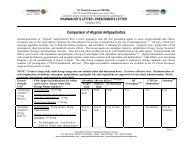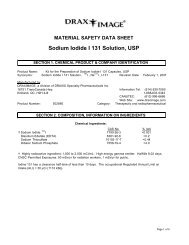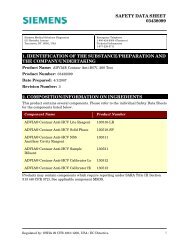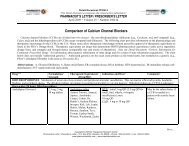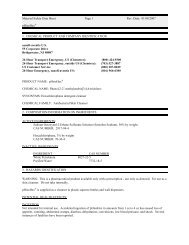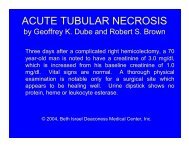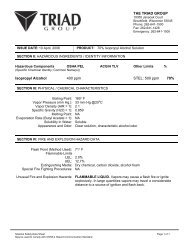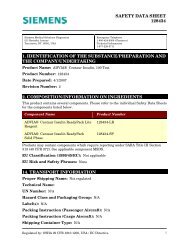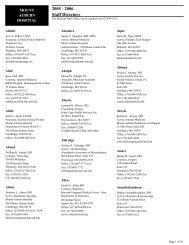Assessment of Patients' Competence to Consent to Treatment
Assessment of Patients' Competence to Consent to Treatment
Assessment of Patients' Competence to Consent to Treatment
You also want an ePaper? Increase the reach of your titles
YUMPU automatically turns print PDFs into web optimized ePapers that Google loves.
clinical pr acticehavioral Research, 2 and in the judgment <strong>of</strong> manyexperts, it reflects how courts actually deal withthese cases.Approaches <strong>to</strong> <strong>Assessment</strong>Given the requirement <strong>of</strong> competence for validinformed consent, the assessment <strong>of</strong> the patient’scapacity <strong>to</strong> make decisions is an intrinsic aspect<strong>of</strong> every physician–patient interaction. Usually, theassessment will be implicit, since in the absence<strong>of</strong> a reason <strong>to</strong> question a patient’s decision making,the presumption <strong>of</strong> competence will prevail. Whenan explicit competence evaluation is required, physiciansshould be aware <strong>of</strong> the relevant criteria andshould be encouraged <strong>to</strong> use a structured approach<strong>to</strong> assessment. In one set <strong>of</strong> studies, simply providingphysicians with specific legal standards <strong>to</strong>guide their judgments, similar <strong>to</strong> the criteria inTable 1, significantly increased interrater agreement(the kappa statistic for agreement increasedfrom 0.14 <strong>to</strong> 0.46). 30,37 Another research groupfound that asking physicians and nurses <strong>to</strong> use asystematic set <strong>of</strong> questions for competence assessmentled <strong>to</strong> a high rate <strong>of</strong> agreement with expertjudgments. 38 Published question sets with goodface validity are readily available, and they shouldbe used <strong>to</strong> guide clinical assessments. 31,38 Table1 includes sample questions.Any physician who is aware <strong>of</strong> the relevant criteriashould be able <strong>to</strong> assess a patient’s competence.Indeed, treating physicians may have theadvantage <strong>of</strong> greater familiarity with the patientand with available treatment options. Psychiatricconsultation may be helpful in particularly complexcases or when mental illness is present. Althougha simple instrument <strong>to</strong> screen patients forimpaired capacity would facilitate the identification<strong>of</strong> patients who may require more detailedassessment, <strong>to</strong> date the quest for a brief neuropsychologicalscreening instrument has not yieldedconsistent findings. However, the Mini–MentalState Examination (MMSE) has been found <strong>to</strong> correlatewith clinical judgments <strong>of</strong> incapacity, 11 andit may have some use in identifying patients at thehigh and low ends <strong>of</strong> the range <strong>of</strong> capacity, especiallyamong elderly persons with some degree <strong>of</strong>cognitive impairment. 39,40 MMSE scores rangefrom 0 <strong>to</strong> 30, with lower scores indicating decreasingcognitive function. No single cut<strong>of</strong>f scoreyields both high sensitivity and high specificity.MMSE scores <strong>of</strong> less than 19 are highly likely <strong>to</strong>be associated with incompetence 39,40 ; studies varyin suggesting that scores <strong>of</strong> 23 <strong>to</strong> 26 or higherare strongly indicative <strong>of</strong> competence. 11,38-40In an effort <strong>to</strong> further standardize and henceincrease the reliability and validity <strong>of</strong> competenceevaluations, several more formal assessment instrumentshave been developed. Their characteristicsand psychometric properties have been describedelsewhere. 41,42 The most widely used <strong>of</strong>these instruments is the MacArthur <strong>Competence</strong><strong>Assessment</strong> Tool for <strong>Treatment</strong>, a structured interviewthat, unlike many other assessment instruments,incorporates information specific <strong>to</strong> a givenpatient’s decision-making situation. 43 Quantitativescores are generated for all four criteria related <strong>to</strong>decision-making capacity, but evalua<strong>to</strong>rs must integratethe results with other data in order <strong>to</strong> reacha judgment about competence. The high interrateragreement on these scores that has been reportedby a number <strong>of</strong> research groups 11,41,44 is usuallygreater than that reported in studies <strong>of</strong> systematicclinical assessment.The MacArthur test takes approximately 20minutes <strong>to</strong> administer and score, assuming thatthe person who administers and scores the test hasexperience with the format and scoring criteria.Given the extra time associated with the use <strong>of</strong>assessment instruments, they would appear <strong>to</strong>have particular value when assessment is especiallydifficult or when a case is likely <strong>to</strong> be resolvedin court, where the availability <strong>of</strong> systematicdata collected in a standard format may beuseful <strong>to</strong> a nonmedical fact finder. However, evenif scores are not generated, the use <strong>of</strong> a structuredinstrument can help guide the clinical assessmentprocess.Whatever approach <strong>to</strong> assessment is used, examinersshould first ensure that patients have beengiven the information that is relevant <strong>to</strong> makingan informed decision about their treatment. Typically,such disclosure includes the nature <strong>of</strong> thepatient’s condition, the nature and purpose <strong>of</strong> theproposed treatment, and the risks and benefits <strong>of</strong>the proposed treatment and <strong>of</strong> alternative treatments,including the option <strong>of</strong> no treatment at all. 1Since such disclosure cannot be presumed, eitherthe evalua<strong>to</strong>r should ask a physician responsiblefor the patient’s care <strong>to</strong> disclose the relevant informationagain in the evalua<strong>to</strong>r’s presence or then engl j med 357;18 www.nejm.org november 1, 2007 1837Downloaded from www.nejm.org at CHILDRENS HOSPITAL-LIB FAGAN PLAZA on November 2, 2007 .Copyright © 2007 Massachusetts Medical Society. All rights reserved.


